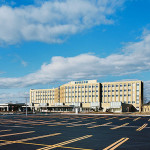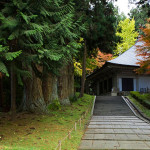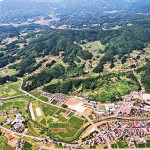Features of Iwate
Boasting fertile land, Iwate is one of Japan’s largest prefectures. Featuring both mountains and the sea, it is blessed with abundant gifts from nature.
The prefecture’s vast mountainous terrain centers around the highest peak in the prefecture, Mount Iwate, also known as Nanbu Fuji (so-called because it resembles Mount Fuji). Nestled in those mountains is Morioka City, and the villages, towns, and cities surrounding it still contain traces that tell the stories of the history and culture of Hiraizumi, our World Heritage Site.
There are many hot springs overflowing with hot water in the prefecture. The coastal region, called Sanriku, has been designated Sanriku Reconstruction National Park (formerly Rikuchu Kaigan National Park). The coast is home to various terrains, with some of the world’s best fishing grounds located off shore. Iwate is also famous for its abundance of fresh seafood.
The prefecture boasts cherry blossoms in the spring, swimming in the summer, autumn foliage, and winter sports, as well as exotic festivals all year round. And you can’t forget about the delicious food.
Iwate: a place that ’s fun to explore year-round.
The people of the prefecture are also praised for their good nature. Everyone in the prefecture is working to welcome foreign researchers to the area in the hopes of the ILC being constructed here.
Location of Iwate
Iwate Prefecture is located in the northeast region of Japan, an area known as Tohoku. It is comprised of 14 cities, 15 towns, and 4 villages, for a total of 33 municipalities. Morioka, the capital of the prefecture, is located at 39°42′ North and 141°09′ East (roughly the same latitude as Washington DC and Lisbon). The prefecture forms an ellipse, extending roughly 122km from east to west and 189km from north to south. It makes up approximately 4% of the total area of Japan with an area of 15,378km2 (slightly larger than Montenegro), making it the second-largest prefecture in Japan next to Hokkaido.
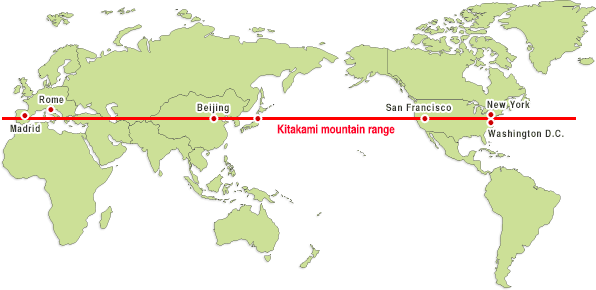
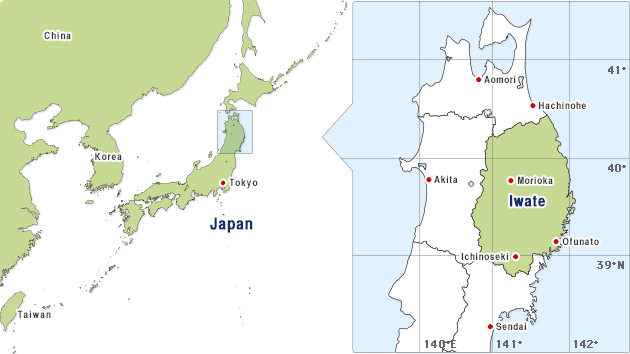
Climate of Iwate
Most of the inland region of Iwate is hilly and mountainous. The Ōu Mountains run along the border of Akita Prefecture to the west, and the Kitakami Highlands lie parallel to that in the east. Between these two mountain systems is a watershed plain in which the Kitakami River flows to the south. The region running alongside the Ōu Mountains to the west side has plenty of good-quality snow in the winter, making it home to some of the nation’s most popular ski resorts.
The inland region has a continental climate, with the Kitakami Highlands exhibiting plateau and basin climates. The temperature in this region fluctuates significantly between summer and winter, daytime and nighttime. The prefectural capital Morioka sees many cold days during the winter. The coastal region has a maritime climate with cool summers and winters that are not as cold compared to the inland region.
The prefecture’s climate varies by region, but our shining quality is that the changing nature of the seasons can be distinctly felt throughout the year.

People in some parts of the prefecture don’t even need air conditioning in the summer. Some families use pellet stoves with timber left over from forest thinning to heat their homes in the winter. You yourself might be able to live in an environmentally-friendly way if you were to live in Iwate.
Around the Kitakami Mountains, the proposed ILC construction site, you can enjoy skiing, snowboarding, and hot springs in the winter. However, you do need studless winter tires to drive during the wintertime.
A Great Environment
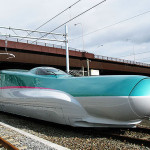
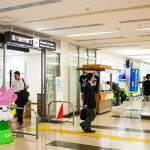
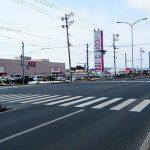
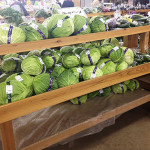
- It’s about a 2-hour and 20-minute trip by bullet train from Tokyo to Iwate. Access to the Tokyo metropolitan area is also convenient by expressway, etc.
- Global access with both Hanamaki Airport and Sendai Airport, and also Haneda Airport in Tokyo
- The nearby city centers offers shopping malls and supermarkets with a variety of foods, clothing, and so on.
- Throughout the prefecture, there are farmers’ markets where you can buy fresh food products. The prices are low compared to the Tokyo metropolitan area.
- There are general hospitals with various departments and in-patient wards in every area throughout the prefecture.
- Organizations like our International Associations strive to make a more global Iwate.
- Ivory and mother of pearl were imported via the Silk Road in order to construct the Golden Hall of the Chuson-ji Temple, our World Heritage Site. Iwate has been in contact with the outside world for at least 900 years.
- The proposed construction site. The area is full of gently-sloping hills, and residential areas (shown:Ichinoseki City).
